Once back form the Galapagos, we stayed in a hostel that rather grandly called itself "the best in South America"- clearly it wasn't, but it was reasonable and in a safe area of town. One of the things that Quito excels at is robberies from gringos - all in a 2-square-block area of the new town where hostels, internet cafes, western restaurants and clubs live on the gringo tourist trade. Far away from this mayhem, our hostel was on the outskirts of the old town, within easy walking distance of the usual colonial architecture, huge churches and central Independence square.
Walking around the Old City was nice, but it was crowded and there were large numbers of riot police around, preparing for a demonstration against Western oil companies operating in the east of the country. Feeling like the cultural heathens that we probably are, we opted against inspecting every church and museum, and abandoned the Old City for a more inspired day. The night before had been "Ecuadorian night" at our hostel - good, typical food and a half decent indigenous band - so we ate in again, up on the beautiful roof terrace that looked over the city.
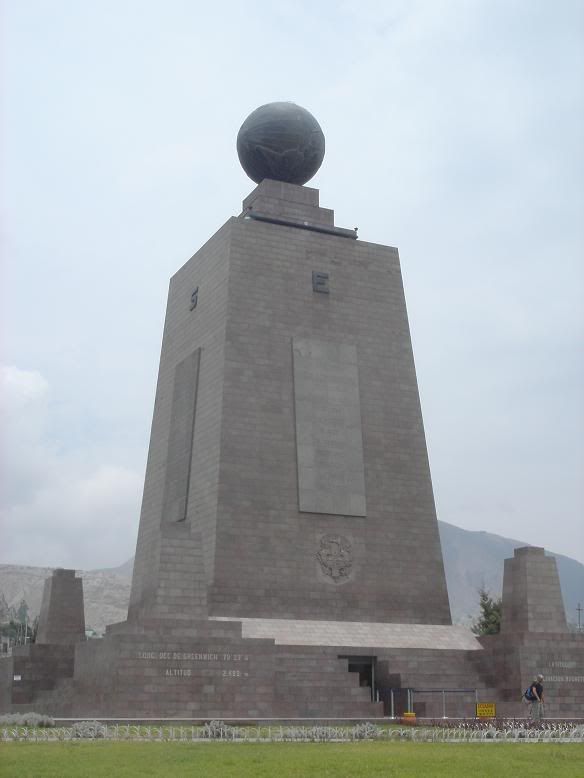
The Official Equator
The next day we set off on a mission to Mitad del Mundo, or the Equator. The bus journey was longer than usual - oil protesters blocking a road - but we reached the huge granite monument just before midday. The position was calculated in 1726, and is only 150m out from the modern day GPS position - they failed to account for the equatorial bulge. After the usual photos we had a look inside the monument - a good ethnographic museum and view from the top was worth the slightly exorbitant entrance fee.
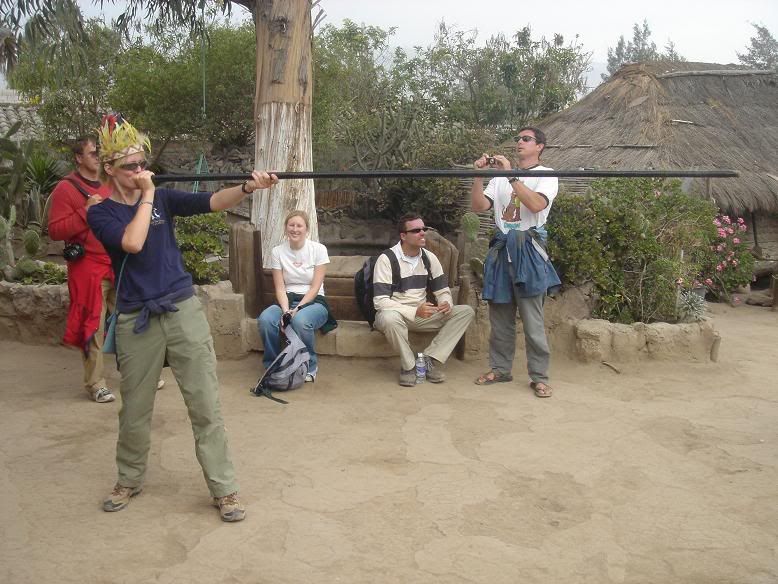
Hannah, tribal warrior-priestess
What we had not counted on was that it was the 23rd of September, or the autumn equinox. That meant, at 12.00pm, we had precisely no shadow as the sun was directly overhead. That would have been great had it not been cloudy. After visiting the "official" (wrong) site, we identified the equator proper in a small museum up a dirt track. There was an eclectic collection of Ecuadorian culture which bulked out the site, including indigneous huts, shrunken heads (actually real human heads that had been skinned off the skull then boiled up in a secret plant concoction that shrinks them into mini-busts; and according to our enthusaistic guide the hair on these heads still grow - weird!) and local drinks. We then got to play with darts and a blow pipe, donning the requisite silly hat before attacking a hapless cactus. Needless to say, I was on target and was immediately crowned chief of the local tribe, being strongly suspected of being a god.

The real Equator
After the tour we got to do the fun stuff on the Equator, namely playing with water and eggs!! There was a great do-it-yourself demonstration of the Coriolis effect - in the northen hemisphere water goes down a plug hole anti-clockwise, on the equator straight down and in the southern hemisphere clockwise. After hours of playing with water we deduced that this was true, even if you only move the bucket 6 inches from the actual equator. Donning our astro-physicist white coats we attempted the second experiment; that was balancing an egg on the head of a nail (which works because of the gravity on the egg is at an equilibrium or something like that - something to do with a bloke called Newton). After several attemptes Pete managed to balance the egg, but as neither of us had actually tried balancing an egg on a nail anywhere other than the equator we weren't sure whether it truely was a gravitational phenomenom or just the guide at the museum having a laugh at us. After taking several photographs with our feet in each hemisphere we returned to Quito, happy to be leaving the following day.
The next morning we were on our way to Baños, a small tourist town a few hours south of Quito, quietly nestling in the foothills of an active volcano. The spa town is a draw for locals and foreigners alike, and arriving on Saturday lunchtime we were met with the usual weekend crowd, tearing around the streets on quad bikes and in dune buggies. The real beauty of the town lies outside of it - the picturesque valleys hide rocky canyons, winding rivers and numerous waterfalls. We spent the next couple of days relaxing - we met Darren and Andrea, a couple from our Galapagos boat, and found an excellent restaurant-cafe with a good book exchange and excellent cookies. We spent time avoiding the awful wails of the karakoe bar opposite our hotel, wandered around town, and generally did very little. Come Monday morning, the town was transformed - quiet, sleepy and empty. We left as well, taking the bus back north to Otavalo, a market town some 2 hours north of Quito.
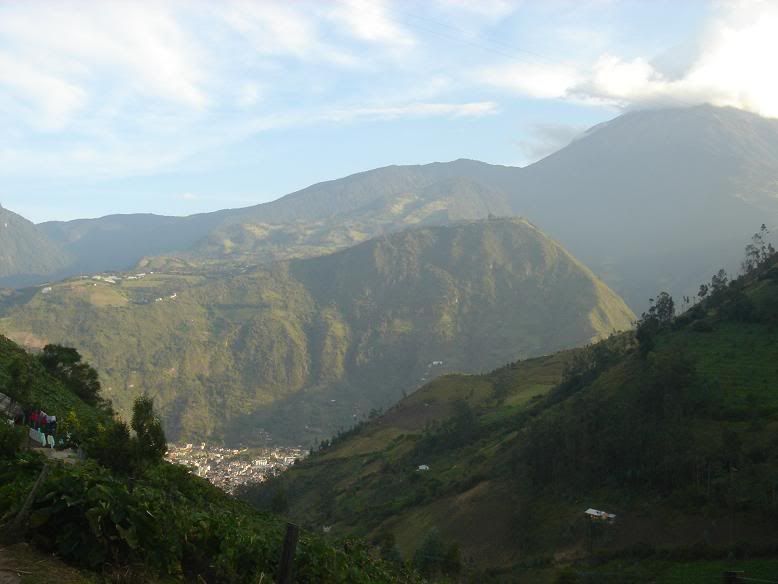
Banos, with Tungurahua volcano behind
Otavalo is famous for having one of the largest markets in South America, every Saturday. The handicrafts market is so big it runs every day of the week, which is what we wanted to see. After arriving we met up with Angie and Meredith for dinner; Angie is a friend who I first met back in Ushuaia, and we have been keeping tabs ever since. All four of us were heading into Colombia, so we decided on the safety-in-numbers option to travel together. Our plan was to look around Otavalo the following morning before taking a bus to Tulcan, on the Ecuador-Colombia border.
Otavalo handicrafts market was not all that good, truth be told. It was nothing that we hadn't seen before, at generally more expensive prices. Instead, Hannah and I took a bus to the nearby town of Cotacachi, famous for it's leather goods. It was a great find. There followed 2 hours of hectic shopping, buying incredibly cheap leather goods that we probably didn't need, but couldn't resist.
Back in Otavalo, we got some lunch before taking the PanAmerican highway northwards. This was where we officially entered the "less secure area" that stretched all the way north to Cali in Colombia. The Ecuadorian government had decared a state of emergency in the 2 provinces east of us, due to ongoing oil protests, and the PanAmerican was apparently blocked north of us due to another protest. After weighing up the risks, we decided to proceed, and arrived that evening safely in Tulcan, having bypassed the "blockade" on the PanAmerica (I suspect I blinked and missed it). We settled down for a comfortable night in Tulcan, with an mixture of trepidation and anticipation about what lay ahead in Colombia.
We crossed the border, hassle-free, first thing in the morning; Angie, who had had her passport stolen in Ecuador, had to promise she would never come back in order to obtain her exit stamp, despite the appropriate paperwork explaining her lack of entry stamp. We took a small van into Ipiales, from where we caught an all day bus up to Cali.
The Colombia-Ecuador border has seen an increase in tension in the past 2 years or so, due to an upsurge in guerrilla activity. Some of the Colombia activites have spilled over into Ecuador, but most of the fighting remains sproadic and in the eastern provinces of the country, far from where we were travelling. Bus travel in Colombia still has the reputation of being risky, in terms of the likelihood of robberies occurring, however. As a counterpoint to the activities of the FARC and other guerrilla groups, in the past 2 years the number of robberies has decreased greatly - mainly a result of a goverment crackdown when most of the bandits ended up in jail or shot.
The day passed quietly and beautifully. The Andes in Colombia has three cordillera that make up the western part of the country, which makes for stunning, lush green scenery that carries on for hours. Rolling hills in the south, with fields and hedges reminiscent of the south west of England, gave way to more tropical vegetation - palm trees, banana plants and coffee farms. The incredible natural beauty was at odds with what many people imagine Colombia as, and the whole journey was one to remember.
As we neared Cali we were stopped at a police checkpoint and the bus was searched. In comparison to the local population, Hannah and I are a pair of fair-headed giants, which immediately drew the attention of the police who demanded we get off for a passport check. After sounding off a little about the police treatment of Colombians in the USA and the UK (Angie and Meredith had to get off too after we mentioned we were not alone), it was all laughs, jokes and smiles as we told him how beautiful Colombia was and how we had had no trouble with the Colombian police. This was the truth, although it also went with my rule of always agreeing with the man with the big shiny gun. What was nicest was that one of the locals got off the bus too, just to check that the police were treating correctly.

Cali - the old and the new
Cali was hot, humid and friendly. Still off the map as most tourism goes, foreigners are welcome and it won't be long before people are flooding to this lively city, second biggest in Colombia but possibly with the biggest personality. After finding a hostel we ate at a good Mexican fast food place; prices are much higher than Ecuador and belts may have to be tightened. The following mornign we set off to explore downtown Cali - a mix of old and new, with the colonial era churches contrasting with the gleaming skyscrapers. The security problems in southern Colombia are limited almost entirely to remote rural regions, but terrorist activity by the guerrilla groups meant that there was a small legion of police in town, most looking rather like Robocop in huge amounts of body armour.
We had decided to stay just the day in Cali, so after a siesta and a visit to an orchid garden, we turned in for the night in prepartion of another long bus ride to Bogotá, capital of Colombia, the following day. This bus ride was much like the first, although in a very luxurious bus reminiscent of Chile and Argentina. The scenery was, again, stunning for most of the day, as we crossed one cordillera and woudn our way slowly up another.
After 10 hours on the bus we arrived in the hectic, large bus terminal of Bogotá. The terminal has an efficient taxi system which prevents unsuspecting tourists being ripped off by dodgey taxi drivers, so after a 30 minute drive through the sprawling city we reached the location of our hostel, without paying over the odds (usually an impossible task arriving in a city). After dashing out and getting some fast food we got an early night to recover from our long day.

Plaza Bolívar, with statue of Simon Bolívar, Colombia's foremost hero
The following day we wandered around the old centre and were very impressed by the central square, Plaza Bolívar, and surrounding rich colonial architecture and presidential palace. The strong security presence was even more noticeable in Bogotá, with several armed police or soliders on every corner, and the occasional fully armed platoon-strength patrol through the streets. Bogotá over the years has been plagued by terrorism, both FARC and drug related, and back in the '80s there was a bomb virtually every weekend. There problem now is much smaller, but the threat from guerrillas remains; before walking down one street we had our bag searched. For all this, the central streets were quiet, pretty and relaxed - a world away from Quito or Lima. That afternoon we went up the tallest tower in Bogotá for a bird's eye view of the city - it is now the fourth largest in South America, but immediately north of the historic centre are a band of green forested hills that are a welcome break from the monotony of concrete.
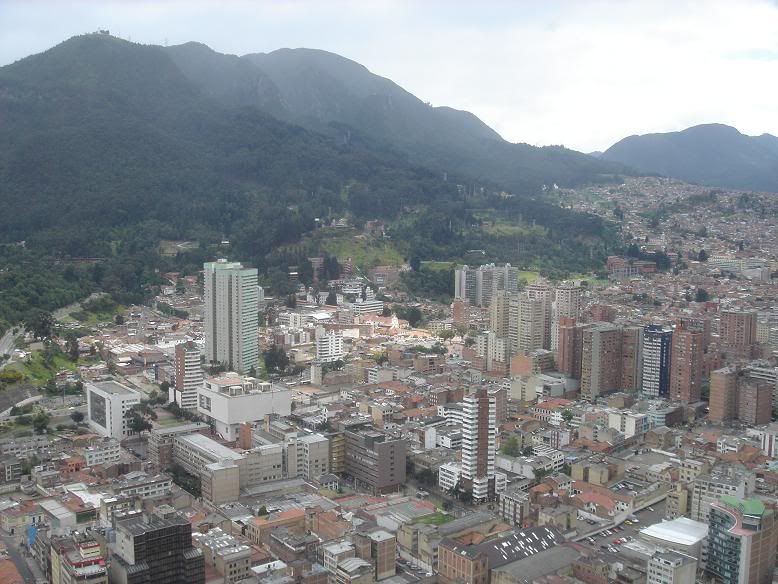
Bogotá centre, from the tower
We awoke the next day to beautiful sunshine and headed up Monserrate, a church that overlooks the city on a hill almost directly above our hostel. We took the funicular up, a tram that climbs the 300m slope up to the church. As it was a Sunday the whole site was busy with worshippers, and we walked around the pretty gardens following the statues depicting the 14 steps of Jesus before he is crucified; something about He falls down 3 times, Simon helps Him carry the cross and Veronica wipes His face….. The views over the city were spectacular with the contrast of the green densely vegetated hillsides against the urban sprawl. We then queued to get the cable car back down to the city.
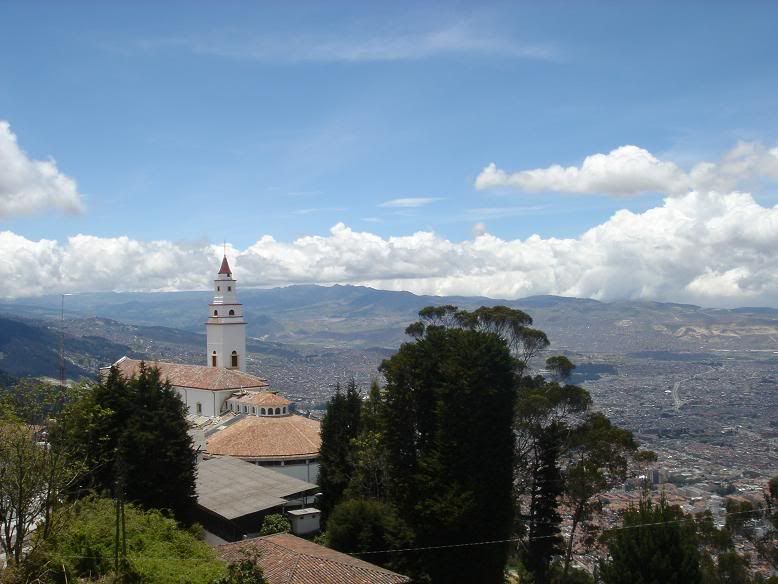
Monserrate
Back in the hostel we waited for Max, a Colombian who had shared Pete's cabin on his Antarctica cruise. He picked us up to take us for lunch in his 4X4 Toyota. Pete noticed that the glass seemed a bit thicker than your average car, and it quickly emerged that we were travelling in an armored plated, bulletproof car. Armored plated cars are not uncommon in Bogotá, in fact we suspected more than 50% of all 4x4s on the road were. We went to the upmarket end of town and had a very nice, very big lunch before returning to Max´s apartment which doubles up as a gallery - he is a very successful photographer. We then went to a nearby café for a coffee before returning to the centre of town and back to our hostel.
Most of the museums and tourist sites in Bogotá are closed on Mondays, so the following day we decided to head back to the upmarket end of town for a spot of shopping and people watching. After looking at several beautiful fabric shops (designer fabrics at designer prices!) we then wandered around one of the several shopping malls in the area, having our bags searched on the way in. In the more nicer area of town there is a big industry in security, a lot of the richer Colombians seem to have their own body guards (as well as armoured cars) - it was bit of a novelty trying to guess the occupation of the man walking down the street, surrounded by a few be-suited gorillas. That evening we returned to the hostel on the TransMilenio – an efficient but complicated bus service that provides rapid transport throughout the city; we managed to get back after a kind gentleman explained the impossible map.
Tuesday morning we set off for Bogotá botanic garden, which housed a wide variety of plants from Colombia and the wider world. There was an excellent arboretum of Andean trees and conifers, plus collections of medicinal plants, roses, palms and cacti. The glass houses contained superb displays of aquatic, orchid, and economic plants (as well as having conveniently located toilets). Unfortuantely I was suffering from a bit of an upset stomach, so we were always on the look out for a convenience stop, and by the afternoon Pete was beginning to feel the ill effects of an unsettled stomach too. We returned to our hostel and decided to spend the rest of the afternoon within a few meters of our en-suite bathroom.
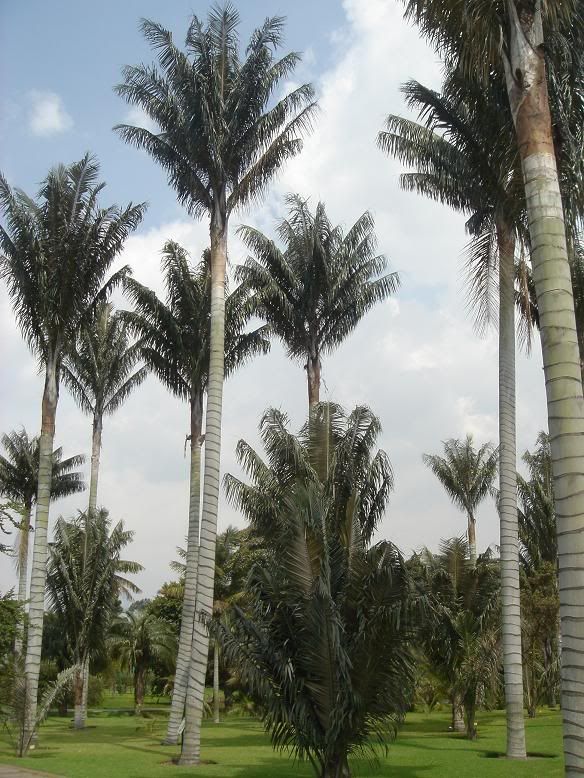
Botanic Gardens
The next morning we awoke, with our stomachs feeling much settled, and set off for the "Salt Cathedral", carved inside a salt mine in the nearby town of Zipaquirá. We called in on our very helpful hostel office where the owner (who according to other travellers should be given a sainthood for his helpfulness) gave us directions on how to get there and a warning of thieves on the TransMileno.
Armed with directions we set off to get the bus, first negociating the complicated TransMileno. When we came to change buses my path was blocked as I followed Pete out onto the platform, and I ended up having to push my way through; only once I’d got out into the fresh air did I realize that the zip pocket of my trousers had been undone and my purse stolen. Fortunately the thief had only got away with all of about two pounds worth Colombian Pesos - luckily I never carry credit cards in my wallet or on the outsides of my clothing. Perhaps most upsetting was that my lucky money bean, which I was given in Manu “if you have a money bean in you purse your money will grow”, had also gone along with the purse.
We arrived in Zipaquirá and walked 20 minutes or so up to the mine, paid our entry fee and joined a group with an English speaking guide for a tour. We walked town a long tunnel until we were 150m under the ground where we started a series of 14 stations representing the 14 stages of Christ being crucified, as we were learning. Each station was a cross that had been sculpted to represent the various stages; Christ falling down (3 times in total) represented by the cross being very low, Simon helping christ – bolders under the cross supporting it. It was all very well done and (best of all) there wasn’t a hint of ornate gold or a gruesome statue to be seen - we are now pretty averse to wealthy religious displays. After we followed all 14 stations we got to the main Cathedral Nave, 180m below the surface, which was brilliantly lit with coloured lighting to represent heaven, hope, purity and Jesus' blood. We had decided that it had been the best church we had ever visited.
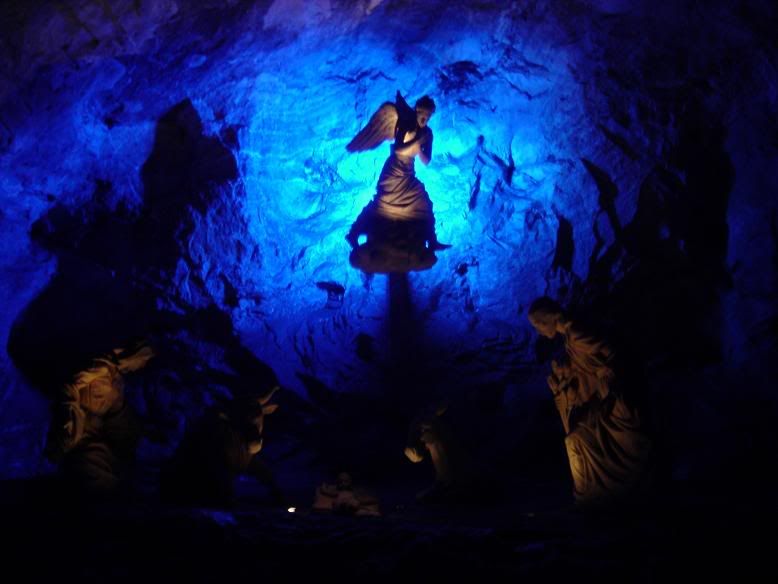
Inside the Salt Cathedral
We returned to Bogotá for lunch, and then went to the excellent, world-famous Museo del Oro, or Gold Museum, owned by the Banco de la República. There was an impressive collection of over 35,000 pre-colombian gold pieces. The ancient objects that have been found throughout different regions of Colombia show virtually every technique known that is used by modern day goldsmiths. I was particularly excited by the immense amount of shiny things. After being mesmerised by all the sparkles and golden glow for an hour and a half, we left for a last look around the centre before leaving the next day for Manizales, in the Zona Cafetera (Coffee Area) of Colombia. Time is running short!

It's shiny, it's heavy, and it clearly won't float

3 comments:
excellent blog as usual guys!
just thought I'd be the first to let you know that igluski have sent an alert out saying it's just started snowing in Val D'Isere!!
Bertie..
Mum calling from Lake Placid. Still sounds exciting to me. fter a warm and lovely week of brilliant fall colours in Vermont we are now in cool damp Adirondacks but the muddy hiking is still good.
you know how they say couples start to look like each other after a while...? I think your cheesy grin might be wearing off pete!
Post a Comment